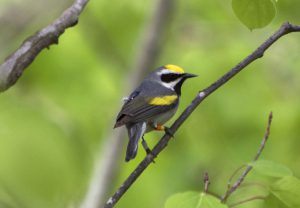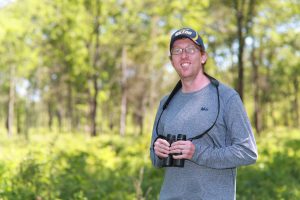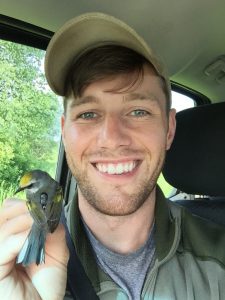Scientists discover single gene that explains songbird migration
August 28th, 2019 by Christine BillauOrnithologists at The University of Toledo played a critical role in new collaborative research identifying a single gene that defines whether rare, tiny songbirds that reproduce in the Great Lakes region and Appalachian Mountains spend their winters in South America or Central America.
Dr. Henry Streby, assistant professor in the UToledo Department of Environmental Sciences, and Gunnar Kramer, Ph.D. candidate in environmental sciences and UToledo graduate dean’s fellow, laid the groundwork for the genetics discovery published this week in the journal Proceedings of the National Academy of Sciences.

Golden-winged warbler
With collaborators at Cornell University, Penn State and the University of Colorado, the team’s findings may have important conservation implications for the declining populations of golden-winged warblers.
Starting six years ago, the UToledo team led a massive collaborative field study: across eastern North America, they caught golden-winged warblers on their breeding grounds, gathered blood samples, placed tiny geolocator technology on the birds, and completed long-distance, cutting-edge migration tracking analysis. Streby and Kramer then gave the samples and data to genetics researchers at Penn State and the Cornell Lab of Ornithology, who performed whole genome resequencing.

Henry Streby
“Only one gene tells the story of the final wintering destination, and it makes sense because it is affiliated with muscles and movement in humans,” Streby said. “Migration is a very complex set of behavioral and physiological traits, and we know this one gene can’t be responsible for all of it. But it’s a critical first step that gives everyone in the field something to build on. This exciting ecology and evolutionary discovery proves the powerful potential of research collaboration.”
Streby and Kramer had already answered the question of where these birds go: golden-winged warblers from declining populations spend winters in northern South America. Stable populations of the species spend winters in Central America.
Researchers at the collaborating universities then used the data and blood samples from the migrating birds to investigate genetic differences between birds that winter in Central America and those that winter in South America. The majority of these differences occurred in a small region on the bird’s Z chromosome, a sex-determining chromosome like the X and Y chromosomes in humans. Only one gene, called VPS13A, was present in this region.
Although the gene does not yet have any known function in birds, in humans it is associated with the neurodegenerative disorder chorea-acanthocytosis, which affects movement.
“In this study, we found only one gene associated with the final wintering destination of golden-winged and blue-winged warblers,” said Dr. David Toews, assistant professor of biology at Penn State and leader of the research team. “As we come to better understand the role of this gene in humans, we may also gain important insights to its role in migration in birds.”
According to the researchers, the gene appears to be a target of natural selection in birds that winter in South America.
“Golden-winged warblers are rapidly declining in the Appalachian Mountains. Conservation efforts have focused on protecting the breeding grounds, which is important, but declines also appear strongly related to habitat alteration and destruction in the wintering grounds,” Streby said.
“The global attention on the fires in the Amazon highlight the importance of these South American habitats, and these migratory birds illustrate an inextricable link between hemispheres,” Toews said.
For Streby and Kramer at UToledo, collecting blood samples from the golden-winged warblers to be used for a later genetics’ investigation was a side project to their study identifying the migratory connectivity of the species. They also recorded the birds singing across their whole range and collected feather samples.
It’s what Streby calls “while-you’re-there science.”
“It’s important to conduct all of the useful science while you have the opportunity because you can’t fund six different projects by six research teams to address six questions in the same study system,” Streby said. “For the DNA samples, we knew we needed to find the right researcher who was looking for migration genes.”

Gunnar Kramer held a golden-winged warbler, which carried a geolocator. Researchers attached the tiny backpack to the bird in 2015 and recovered it in 2016. The data on the geolocator helped Kramer understand the warbler’s migratory route and winter location.
Kramer met Toews and Dr. Scott Taylor, assistant professor of ecology and evolutionary biology at the University of Colorado, at the North American Ornithological Conference in Washington, D.C., in 2016.
“I quickly realized we had valuable genetic samples that they needed to do exciting complementary research, and we were happy to share our science,” Kramer said. “By working together, we now know what we suspected – there is a genetic component to migration. However, we’re fascinated it appears to be just one gene that explains the major migration divide in the system.”
The study was supported by the Natural Sciences and Engineering Research Council of Canada, the National Science Foundation, The University of Toledo, the Cornell Lab of Ornithology, the United States Geological Survey, the United Sates Fish and Wildlife Service, the University of Minnesota and the University of Tennessee.
Christine Billau is
UT's Media Relations Specialist. Contact her at 419.530.2077 or christine.billau@utoledo.edu.
Email this author | All posts by
Christine Billau

